

The Chubb Archive is part of The History of Locks Museum Resources
Contact our curator for more information
© 2004 - 2018

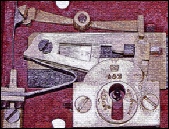
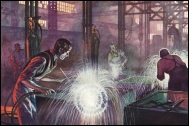
Your one-stop resource for dating & information on vintage and antique Chubb Locks, Safes & Security Equipment
THE AUBIN TROPHY
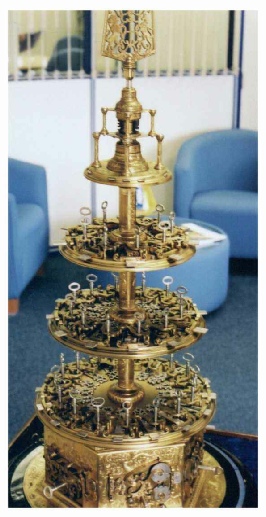
Just why and when Charles Aubin disposed of this wonderful example of mechanical engineering is a mystery. Papers belonging to Mr. A.C. Hobbs, which formed the basis for a ‘Treatise’ entitled “Construction of Locks and Safes circa 1850” contain the statement “this trophy is now in the possession of Mr. Hobbs”. It can only be assumed that Hobbs purchased the trophy from Charles Aubin after the exhibition closed. The manuscript for the treatise was compiled during 1852/53 and edited by Mr. C. Tomlinson.
Mr. Hobbs, born in Boston, Mass. USA, attended the 1851 Great Exhibition representing the American Lock Makers - Messrs. Day & Newell of New York. He arrived in London some two months before the Exhibition and was the instigator of the great “Lock Controversy” in July of that year.
Following the exhibition he remained in London, setting up Hobbs & Company (registered 1852) to produce American Locks. By 1855 the name had changed to Hobbs, Ashley & Co., soon to become Hobbs, Ashley and Fortescue with an address at 97, Cheapside, London. Hobbs never intended to stay in England and when Ashley died in 1860 he sold the thriving business to J. M. Hart and returned to America. Having stipulated that his name should always head the Company, it became Hobbs, Hart & Company. By 1864, the address was 76, Cheapside, London.
For some reason, Hobbs did not take the ‘Trophy’ to America; perhaps a ’deal’ was made to ensure it remained in England or it may have been part of the Company’s Assets when Mr. Hart purchased the business. It remained at the Cheapside office during the following 96 years.
In 1956 Hobbs Hart & Co. became part of Chubb & Son’s Lock & Safe Co. Ltd. and care of the trophy became Chubb’s responsibility. During the early 1960’s it was moved to their Head Office in London W.1. Following the Racal takeover (1984) the Chubb Lock & Safe Head Office subsequently moved to Wolverhampton in 1987 and the trophy returned to the town where it was originally manufactured. Changes in ownership of the Chubb Group during recent years might have resulted in its loss but this is not the case; although lock and safe production has ceased at Wednesfield Road, Chubb Safes UK still have their administration and sales offices on what remains of the site and the trophy is currently in their care. It is housed in a modified Bankers Safe which doubles as a secure container during transit to exhibitions etc.
In July 2002 the Company were surprised to receive a letter from Mrs. June James, a Great Great Granddaughter of Charles Aubin, explaining that she was researching the family history. Her mother, Mrs. Eileen Jenkins had known the trophy existed but had never seen it and an aunt thought Chubb might be able to help her locate it. As a result the Company were delighted to arrange a personal visit for June, Mrs. Jenkins and a further five direct descendants of Charles Aubin.
Designed and constructed by Mr. Charles Aubin of Wolverhampton for the 1851 Great Exhibition this is without doubt, a unique piece of engineering. One of the many mechanical machines on display, the “Trophy” attracted very little notice at the time, possibly due to the huge publicity caused by the ‘Lock Controversy’ that occurred through July and August that year. The description in the Official Illustrated Catalogue for the exhibition reads as follows:
“Specimens to illustrate the rise and progress of the art of making locks, containing forty-four different movements by the most celebrated inventors in the lock trade”
A hexagonal base supports a central column about 36 inches high. Three circular platforms are horizontally attached to the column at different heights. Each of the vertical faces of the base contains a lock operated by its own key (nos. 38 - 43 in the list of locks). Each circular platform contains a number of locks, 16 on the lowest, 12 on the next and 9 on the top. At the top of the central column is a Bramah lock (no. 44), the crowning glory!
The locks on each platform are arranged so that their bolts shoot outwards or radially away from the axis of the machine. Every lock has its own correct key inserted in the keyhole and attached to the key pin. Since the locks are placed horizontally, the shaft of each key is vertical. Within each of the platforms and the central column is a delicate mechanism of levers, racks and pinions. These are linked to the barrel of the Bramah lock. Operation of this by its key causes horizontal rotation and rotary movement of the vertical rod inside the centre column. At each platform level this rod operates on the racks and pinions and these in turn, act upon the key pins in each lock. Turning the Bramah Key causes all of the key pins and keys to rotate, thus moving all the individual lock bolts simultaneously. Depending on the direction in which the Bramah key is turned, the lock bolts are either thrown or withdrawn.
Each of the forty-four locks is a faithful reproduction of the several patents or mode of construction to which they refer. The lock cases are ‘cut-away’ to provide a view of the principle in each design.
The following description is an extract from the 1856 publication by George Price titled:
“Fire & Thief Proof Depositories & Locks & Keys”
Lock numbers and description
Bottom Platform (lock nos. 1 - 16)
- Marked Roman this has a single bolt with binder spring to hold the bolt in any position until sufficient force is applied to overcome the spring pressure.
2. Marked French this resembles lock no.1 in every way except having the addition of a friction roller.
(Note: The bolts in nos.1 & 2 can be forced back by end pressure)
3. Marked Ancient this is a bolt-lock as found in an ancient building. It exhibits an improvement on nos.1 & 2 since before it can be moved, the bolt must be pressed down by the key or some other implement in order to release it from a catch at the back end of the bolt.
4. Also marked Ancient but movement of the bolt is controlled by a single acting lever; that is one in which over-lifting of the lever still releases the bolt.
5. Marked Old English this lock has a double-acting lever that must be lifted to a precise position to release the bolt.
6. Marked Modern English (no makers name), is a single-acting lever lock.
7. By Mace has a double-acting lever.
8. By Somerford and is his first patent. It is a double-acting draw lever lock; the lever is drawn down to release the bolt instead of being lifted.
9. Marked Indian this is a single-acting lever with a pin.
10. By Wm. Thompson (1805 patent) having two levers, one single and the other double-acting.
11. Daniells
12. Walton
13. Barron (1st Patent - 1774)
14. Bickerton
15. Is a Dutch lock
16. By Duce (senior)
Middle Platform (Nos. 17 - 28)
17. By Sanders - this has four double-acting levers.
18. Thomas Cornthwaite (patent 7 July 1789); very similar to
lock no.17.
19. By Richard and Peers.
20. By Somerford (his 2nd patent) which seems to follow Tann’s principle of ‘reliance-wards’ - see lock no. 33.
21. By Thomas Rowtree - patent 23 Feb. 1790.
22. By Duce (junior) - his 1st Patent in 1823.
23. By Thomas Parsons - patent 20 Dec. 1832.
24. By Bickerton - his second lock.
25. By Price (patented in 1774) - the first lock to have four double- acting levers.
26. By Charles Aubin who introduced this lock in 1830 and included a revolving curtain for the purpose of closing the keyhole during the revolution of the key.
Note: Other inventors copied this and an 1852 patent ‘claims’ this component as part of the patent.
27. By Robert Barron (the 1778 patent - his second) with double- acting levers.
28. By Bird (1790 patent).
Top Platform (Nos. 29 - 37)
29. By Duce (junior) - his second patent dated 24 May 1842.
30. By Ruxton dated 1818.
31. By Chubb patented 1824 - simplified form of the original Detector Lock.
32. By Marr - no date available.
33. By Tann (Nov. 1843 patent) with the ‘reliance wards’.
34. By Ebenezer Hunter - 20 Dec.1833 patent in the names of Charles Chubb, London and
E. Hunter, Wolverhampton.
35. By T. Parsons (2nd patent - Dec. 1833).
36. By Lang (1830).
37. By Lawton (patent 7 Mar.1815 - in the names of Wm. Mitchell, Glasgow and John Lawton, London).
Base (Nos. 38 -43)
38. By Strutt (patented 1819? ) has an arrangement for holding the levers should pressure be applied to the bolt.
39. By R. Scott (patented Feb. 1801?)
40. By Jeremiah Chubb (patent 3 Feb. 1818) the original Detector- Lever Lock.
41. By T. Parsons (patent Dec.1833) is a changeable lock of peculiar construction. The elevation of the tumblers is regulated by an adjusting-screw passing through the lock to the inside of the door. This screw changes the positive but not the relative positions of the tumblers; the same difference in the steps of the key must be retained the change being made only in the length if the bit. The number of changes for each lock is very limited.
42. By Pierce (1840 patent) incorporates a spring-loaded barb concealed below the keyhole. Accidental over-lifting of the levers releases the barb!
43. By Thomas Ruxton (14 May 1816 patent) - this lock is fitted with an indicator which is activated if a lever is over-lifted in an attempt to pick the lock. The indicator only becomes visible when the lock is opened.
44. The trophy is surmounted by the Joseph Bramah lock (first patent Jan.1784) with a beautifully engineered Key.
See bottom of page for larger pictures
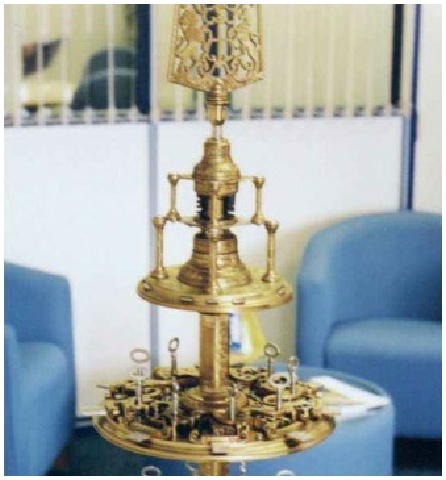
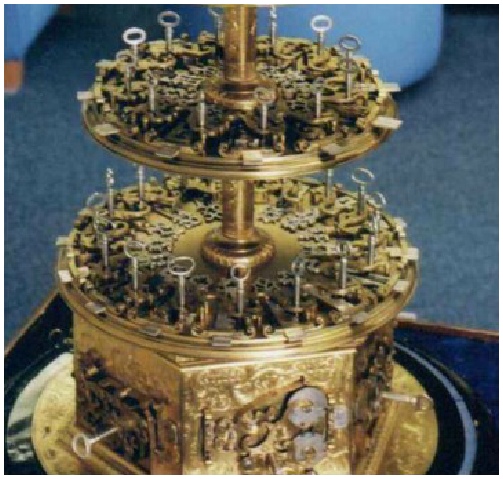
Picture shows Bramah key and lock above the top platform bearing nine locks
Picture shows the base (total of six locks),
bottom platform (total of 16 locks) and
middle platform (total of 12 locks)
Lock Nos. 11 - 16 all have
Single-acting levers. The differences between each of them are too small to warrant individual descriptions.
For more archive information and pictures see: HoL Archive-The Aubin Trouphy
This trophy is in the care of Gunnebo UK Ltd - see ‘Links’ page for contact information
Home | Previous Page | ToP | Next Page
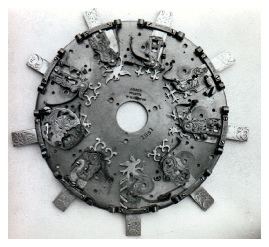
Detail pictures taken in 1958 by Bill Stanton during restoration shortly after Chubb acquired the trophy.
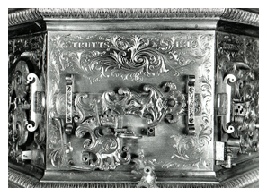
| Chubb 1818-1990s |
| Chatwood-Milner |
| Chubb Family |
| Early Sales/Offices/ChubbGroup/1980s & on |
| The Detector Mechanism |
| Photographs |
| Chubb Money Boxes |
| The Aubin Trophy |
| Lock Number 696 |
| Williams acqusition |
| Arthur Briant |
| Ibbs - Export is Fun |
| Peter Gunn |
| Back to Work |
| First Steps |
| My Export Career begins |
| The Happy Years |
| Export Manager |
| Back to The Midlands |
| Back to The Midlands - part 2 |
| Australia |
| The Midlands - again! |
| The Final Years |
| Conclusions |
| Slingsby Dart T51 Sailplane |
| Latest News |